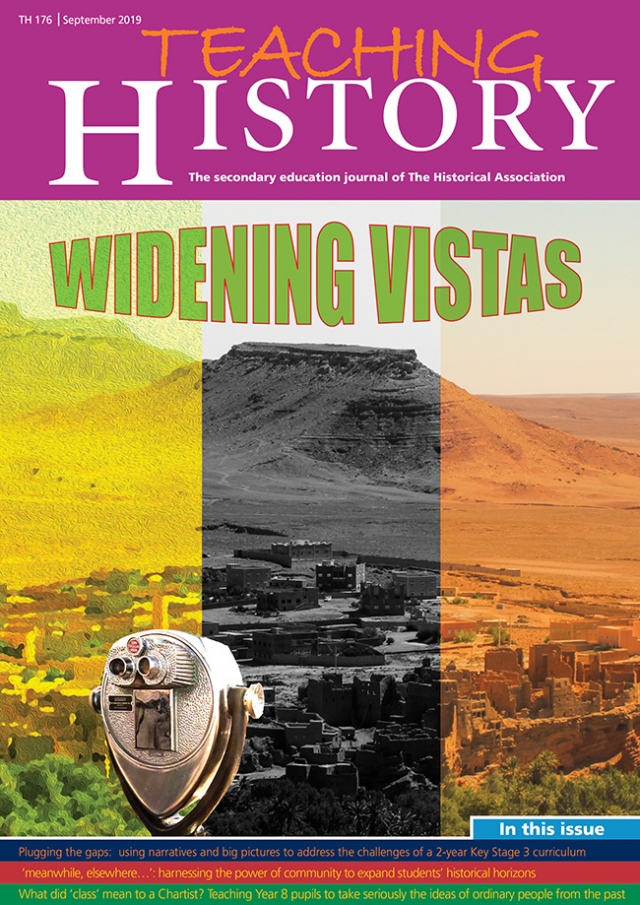Teaching History 176: Out now
The HA's journal for secondary history teachers

Widening Vistas
"History is like a palimpsest, a medieval parchment in which, as the ink of one set of writing faded, another document was written on top of it, until over the years several layers of writing accumulated, one on top of the other…"
In this vivid image, historian Richard Evans, in his prologue to What is History Now?, captures how history has proliferated over recent decades.1 As the number of professional historians has increased exponentially as a consequence of higher education’s expansion, so have the means of studying the past (the methods, practices and theories of the discipline) and with it the pursuit of new knowledge. This development undoubtedly has enriched the discipline, as new forms of history open up exciting new vistas on the past or cast familiar terrain in fresh light. As Felipe Fernández-Armestro puts it, writing in the same volume, ‘there is simply so much more to learn from’.2
Yet this expansion also presents significant challenges. As historians’ research and publications have become increasingly specialised, history has fragmented into an array of narrow sub-disciplines, a development which Evans argues has damaged history’s ability to communicate with a wider audience.3 This is surely not what E.H. Carr had in mind when, nearly sixty years ago, he called for a broadening of the horizons of history.4
These tensions are reflected in debates about what history pupils should be taught in schools. Over the past forty years the overall trajectory of the kind of history taught in schools has been towards a broadening of content away from a narrowly Anglocentric history dominated by high politics. Simultaneously, different forms of history have increasingly found their way into the school classroom, as the pages of this journal attest.5 Thus the authors writing in this edition build on a long tradition of professional debate and practice. Alongside their determination to expand pupils’ substantive and disciplinary horizons is a concern with the ‘vista’, the view of the past pupils are left with. This concern, while not new, has been given new impetus by the increased knowledge demands of GCSE specifications and by the new OFSTED inspection framework that places curricular decision-making front and centre. Wrestling with these issues, the articles demonstrate a keen awareness of the awesome responsibility exercised by teachers in making judgements about what to include in, and what to omit from, the curriculum.
Several articles tackle this issue head on. Will Bailey-Watson and Richard Kennett, in outlining the rationale for their project ‘meanwhile, elsewhere...’ call history teachers to consider whether they need to broaden the geographical scope of their curricula in order to incorporate histories that are often overlooked. Bailey-Watson and Kennett use homework tasks to introduce pupils to events geographically and culturally distant but temporally concurrent with topics that pupils have been studying in their lessons. Drawing on the experiences of teachers who have used the resources they show how ‘meanwhile, elsewhere...’ can enrich pupils’ perspective by helping them make connections across time and space and spot resonances. Kerry Apps, while sharing these concerns, adopted a different approach. Frustrated by the limitations which she had identified in her existing scheme of work on Tudor England, Apps sought to apply a new lens to the period. Working in collaboration with a group of teachers and historian Miranda Kauffman, Apps designed an enquiry that used a series of depth studies on remarkable individuals with which to illuminate the rich connections that existed between Tudor England and the wider world. She reports how the enquiry added complexity to pupils’ view of what the Tudor ‘world’ was and who ‘belonged’ in it.
Helping pupils to make connections across the curriculum is also an important feature of the work reported by Natalie Kesterton. Faced with the challenge of implementing a two-year Key Stage 3, she outlines two practical strategies she developed to address deficits in pupils’ chronological security and sense of period. In evaluating her efforts, Kesterton reflects on what kinds of ‘big picture’ knowledge she wants her pupils to acquire by the end of the key stage. Alex Ford is also concerned with narrative coherence, albeit on a different scale – a GCSE period study. He argues that the content outlined in examination specifications does not in itself provide a coherent narrative or reflect the complexities of scholarly discourse. Ford offers an account of how he sought to reconcile two aims: preparing pupils for the demands of the examination while ensuring that the history studied by pupils reflects the rigour, richness and complexity of current scholarship.
Reporting on case-study research undertaken during his initial teacher training, Jacob Olivey reflects on his efforts to enrich his Year 8 pupils’ understanding of a substantive concept (‘class’). Inspired by academic scholarship, Olivey wanted pupils to reflect on the value of substantive concepts to an historian as a label, as well as their meaning to ordinary people engaged in constructing their own identities. He concludes that if pupils are to work effectively with substantive concepts, they need masses of concrete detail nested within secure narratives. Kathryn Elsdon and Hannah Howard also drew direct inspiration from scholarship in their determination to introduce Key Stage 3 pupils to the history of material culture. Recounting their efforts to plan an enquiry on the British Empire they show how drawing on the methodologies used by historians can open up new lines of enquiry when working with source material and artefacts.
References
1 Evans, R. (2002) ‘Prologue’ in D. Cannadine (ed.) What
is History Now? Basingstoke: Palgrave Macmillan
2 Fernández-Armestro, F. (2002) ‘Epilogue’ in D.
Cannadine (ed.) What is History Now? Basingstoke: Palgrave Macmillan
3 Evans, op. cit.
4 Carr, E. H. (1961) What is History? London: Penguin.
5 See for example Hammond K. (2007) ‘Teaching Year 9 about historical theories and methods’ in Teaching History, 128, Beyond the Exam Edition.

